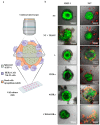Targeting HER2-Positive Solid Tumors with CAR NK Cells: CD44 Expression Is a Critical Modulator of HER2-Specific CAR NK Cell Efficacy
- PMID: 40075578
- PMCID: PMC11898473
- DOI: 10.3390/cancers17050731
Targeting HER2-Positive Solid Tumors with CAR NK Cells: CD44 Expression Is a Critical Modulator of HER2-Specific CAR NK Cell Efficacy
Abstract
Background/Objectives: Monoclonal antibody therapies for HER2-positive tumors frequently encounter resistance, requiring alternative treatment strategies. This study investigates the use of natural killer (NK) cells expressing HER2-specific chimeric antigen receptor (CAR) to address this issue. CAR NK cells have several benefits over CAR T cells: they are less likely to cause severe side effects such as cytokine release syndrome and neurotoxicity, can be sourced from various origins, and do not trigger Graft versus Host Disease, making them ideal for "off-the-shelf" applications. Methods: We have generated NK-92 cell lines expressing first, second and third-generation HER2-specific CARs with CD28 and/or 41BB costimulatory domains using a retroviral transduction system, followed by FACS sorting and expansion to obtain pure HER2-CAR NK-92 cell products for functional benchmarking. Results: In vitro tests showed that these CAR NK cells were effective against both trastuzumab-sensitive (CD44-) and -resistant (CD44+) tumors in monolayer cultures. However, in three-dimensional spheroid models and in vivo xenografts, they were less effective against CD44+ trastuzumab-resistant tumors. Conclusions: This reduced efficacy highlights the significant role of the tumor microenvironment, particularly the extracellular matrix, in hindering the therapeutic potential of CAR NK cells. Despite the promising in vitro performance of CAR NK cells, this study emphasizes the need for improved strategies to enhance their penetration and effectiveness in resistant tumors: optimizing CAR constructs and devising methods to overcome extracellular matrix barriers are crucial for advancing CAR NK cell therapies in oncology.
Keywords: CAR NK cell; CD44; HER2-CAR; extracellular matrix; solid tumor; trastuzumab.
Conflict of interest statement
The authors declare no conflicts of interest.
Figures





References
-
- Barok M., Isola J., Palyi-Krekk Z., Nagy P., Juhasz I., Vereb G., Kauraniemi P., Kapanen A., Tanner M., Vereb G., et al. Trastuzumab causes antibody-dependent cellular cytotoxicity-mediated growth inhibition of submacroscopic JIMT-1 breast cancer xenografts despite intrinsic drug resistance. Mol. Cancer Ther. 2007;6:2065–2072. doi: 10.1158/1535-7163.MCT-06-0766. - DOI - PubMed
-
- Lee K.M., Nam K., Oh S., Lim J., Kim Y.P., Lee J.W., Yu J.H., Ahn S.H., Kim S.B., Noh D.Y., et al. Extracellular matrix protein 1 regulates cell proliferation and trastuzumab resistance through activation of epidermal growth factor signaling. Breast Cancer Res. 2014;16:479. doi: 10.1186/s13058-014-0479-6. - DOI - PMC - PubMed
-
- Bourguignon L.Y., Shiina M., Li J.J. Hyaluronan-CD44 interaction promotes oncogenic signaling, microRNA functions, chemoresistance, and radiation resistance in cancer stem cells leading to tumor progression. Adv. Cancer Res. 2014;123:255–275. doi: 10.1016/B978-0-12-800092-2.00010-1. - DOI - PMC - PubMed
Grants and funding
LinkOut - more resources
Full Text Sources
Medical
Research Materials
Miscellaneous

